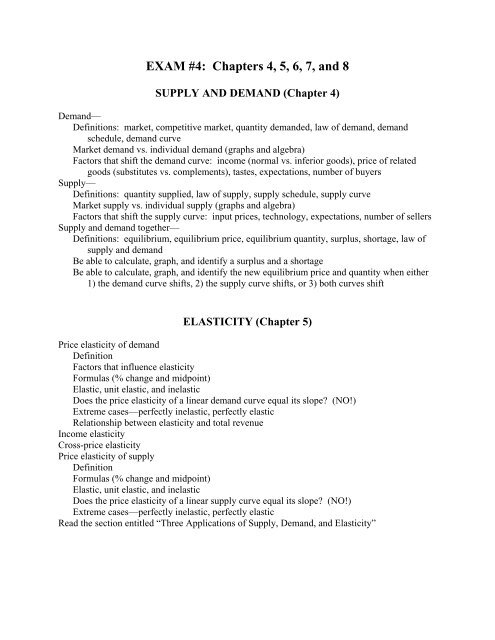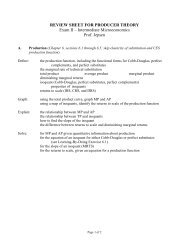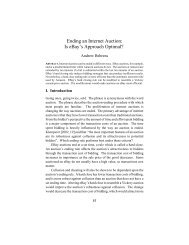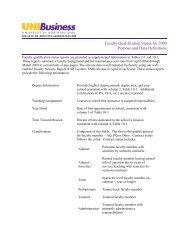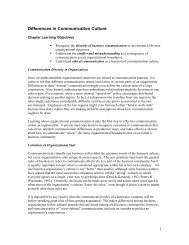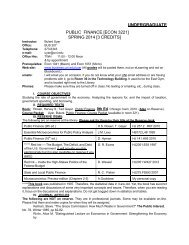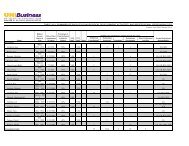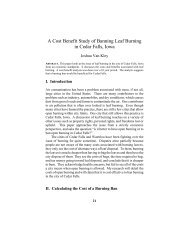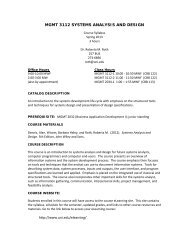The Market Forces of Supply and Demand (Chapter 4):
The Market Forces of Supply and Demand (Chapter 4):
The Market Forces of Supply and Demand (Chapter 4):
- No tags were found...
Create successful ePaper yourself
Turn your PDF publications into a flip-book with our unique Google optimized e-Paper software.
EXAM #4: <strong>Chapter</strong>s 4, 5, 6, 7, <strong>and</strong> 8SUPPLY AND DEMAND (<strong>Chapter</strong> 4)Dem<strong>and</strong>—Definitions: market, competitive market, quantity dem<strong>and</strong>ed, law <strong>of</strong> dem<strong>and</strong>, dem<strong>and</strong>schedule, dem<strong>and</strong> curve<strong>Market</strong> dem<strong>and</strong> vs. individual dem<strong>and</strong> (graphs <strong>and</strong> algebra)Factors that shift the dem<strong>and</strong> curve: income (normal vs. inferior goods), price <strong>of</strong> relatedgoods (substitutes vs. complements), tastes, expectations, number <strong>of</strong> buyers<strong>Supply</strong>—Definitions: quantity supplied, law <strong>of</strong> supply, supply schedule, supply curve<strong>Market</strong> supply vs. individual supply (graphs <strong>and</strong> algebra)Factors that shift the supply curve: input prices, technology, expectations, number <strong>of</strong> sellers<strong>Supply</strong> <strong>and</strong> dem<strong>and</strong> together—Definitions: equilibrium, equilibrium price, equilibrium quantity, surplus, shortage, law <strong>of</strong>supply <strong>and</strong> dem<strong>and</strong>Be able to calculate, graph, <strong>and</strong> identify a surplus <strong>and</strong> a shortageBe able to calculate, graph, <strong>and</strong> identify the new equilibrium price <strong>and</strong> quantity when either1) the dem<strong>and</strong> curve shifts, 2) the supply curve shifts, or 3) both curves shiftELASTICITY (<strong>Chapter</strong> 5)Price elasticity <strong>of</strong> dem<strong>and</strong>DefinitionFactors that influence elasticityFormulas (% change <strong>and</strong> midpoint)Elastic, unit elastic, <strong>and</strong> inelasticDoes the price elasticity <strong>of</strong> a linear dem<strong>and</strong> curve equal its slope? (NO!)Extreme cases—perfectly inelastic, perfectly elasticRelationship between elasticity <strong>and</strong> total revenueIncome elasticityCross-price elasticityPrice elasticity <strong>of</strong> supplyDefinitionFormulas (% change <strong>and</strong> midpoint)Elastic, unit elastic, <strong>and</strong> inelasticDoes the price elasticity <strong>of</strong> a linear supply curve equal its slope? (NO!)Extreme cases—perfectly inelastic, perfectly elasticRead the section entitled “Three Applications <strong>of</strong> <strong>Supply</strong>, Dem<strong>and</strong>, <strong>and</strong> Elasticity”
GOVERNMENT POLICIES (<strong>Chapter</strong> 6)Definitions: price ceiling, price floor, tax incidenceBe able to calculate, graph, <strong>and</strong> identify a price ceiling <strong>and</strong> a price floor <strong>and</strong> analyze examples(rent control, minimum wage, agricultural price support, etc.)Be able to calculate, graph, <strong>and</strong> identify the tax incidence if a tax is levied on buyersBe able to calculate, graph, <strong>and</strong> identify the tax incidence if a tax is levied on sellersRelationships between elasticity <strong>and</strong> tax incidenceEFFICIENCY OF MARKETS (<strong>Chapter</strong> 7)Definitions: welfare economics, willingness to pay, consumer surplus, cost, producer surplus,total surplus, efficiency, equity[Note: make sure you read the examples <strong>of</strong> consumer surplus <strong>and</strong> producer surplus in the book]Be able to calculate, graph, <strong>and</strong> identify consumer surplus <strong>and</strong> producer surplusTAXATION (<strong>Chapter</strong> 8)Definitions: deadweight lossBe able to calculate, graph, <strong>and</strong> identify consumer surplus, producer surplus, total surplus, taxrevenue, <strong>and</strong> deadweight loss in a market 1) with a tax or 2) without a taxBe able to identify <strong>and</strong> explain how the price elasticity <strong>of</strong> dem<strong>and</strong> <strong>and</strong> the price elasticity <strong>of</strong>supply affect the size <strong>of</strong> deadweight lossBe able to identify <strong>and</strong> explain how the size <strong>of</strong> a tax affects the size <strong>of</strong> tax revenue <strong>and</strong> <strong>of</strong>deadweight loss


